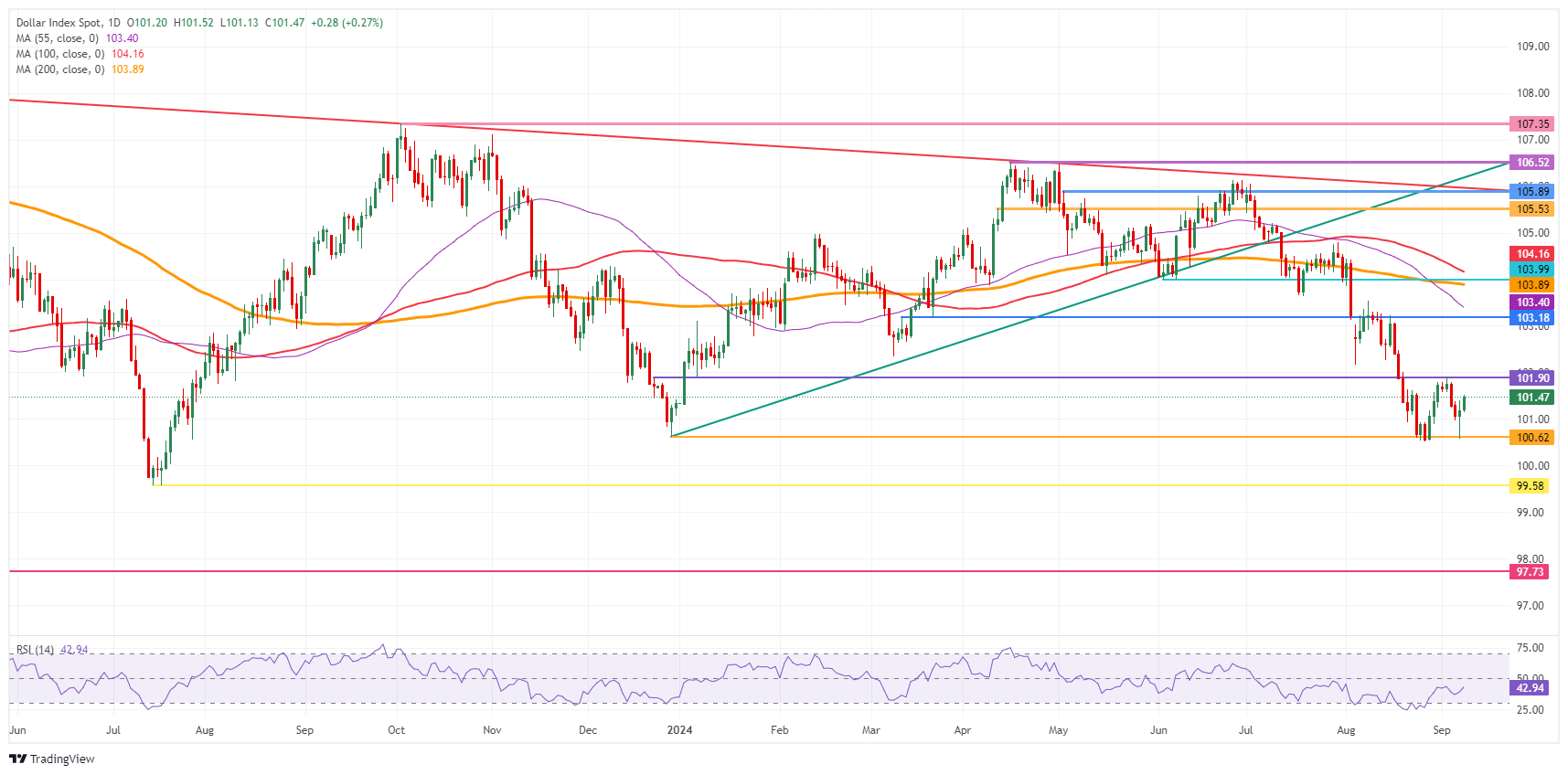- The US Dollar holds on to gains ahead of the US trading session on Monday.
- Comments from Fed’s Waller and the mixed Nonfarm Payrolls print are enough to fuel a stronger US Dollar for now.
- The US Dollar Index pops above 101.50 and looks to be heading towards 101.90 for a test.
The US Dollar (USD) edges higher on Monday and extends gains for a second consecutive day after US Federal Reserve (Fed) Governor Christopher Waller did not convince markets that the September interest rate cut will be a 50 basis point one. Instead, with the mixed Nonfarm Payrolls release on Friday, markets look to settle for only a 25 basis point rate cut, which means that the Greenback has been punished too much in recent weeks and needs to gain a bit to get the right valuation.
On the economic data front, this week has three pivotal points. For the US side, the US Consumer Price Index (CPI) for August release on Wednesday will be the main driver. On the European side, the European Central Bank will deliver its interest rate decision on Thursday, ahead of the Fed’s rate decision next week. Meanwhile, the US presidential election will step to the forefront again with a debate between former US President Donald Trump and Democratic candidate Kamala Harris on Wednesday.
Daily digest market movers: Inventories mild jump
- At 14:00 GMT, the US Census Bureau has released the Wholesale Inventories Index for July. Previous number came in at 0.3% with a positive 0.2% for July.
- The US Treasury will auction some short-term paper at 15:30 GMT, with a 3-month and a 6-month bill auction.
- At 19:00 GMT, the Consumer Credit Change for July is expected to jump to $12.2 billion from $8.93 billion prior.
- Equities in Asia have closed down again by on average 1%. European and US equities are rather chosing positive numbers with nearly all major European indices and US futures up by 1%.
- The CME Fedwatch Tool shows a 73.0% chance of a 25 basis points (bps) interest rate cut by the Fed on September 18 against a 27.0% chance for a 50 bps cut. For the meeting on November 7, another 25 bps cut (if September is a 25 bps cut) is expected in November by 32.6%, while there is a 52.5% chance that rates will be 75 bps (25 bps + 50 bps) and a 14.9% probability of rates being 100 (25 bps + 75 bps) basis points lower.
- The US 10-year benchmark rate trades at 3.73%, gradually trading higher on the day.
US Dollar Index Technical Analysis: Dollar rolls through markets
The US Dollar Index (DXY) is looking for its fair value after markets devalued the Greenback a bit too far in the assumption that the Fed would have to cut bigger and quicker than the US data is actually suggesting. That repricing looks to be on its way with a stronger US Dollar this Monday and leaves a fair warning for traders and markets. The Fed determines each policy meeting on the data coming in, which means each meeting might not be what markets expect it to be.
Looking at key technical levels, the first resistance at 101.90 is getting ready for a second test after its rejection last week. Further up, a steep 2% uprising would be needed to get the index to 103.18. The next tranche up is a very misty one with the 55-day Simple Moving Average (SMA) at 103.40, followed by the 200-day SMA at 103.89, just ahead of the big 104.00 round level.
On the downside, 100.62 (the low from December 28) holds strong and has already made the DXY bounce four times in recent weeks. Should it break, the low from July 14, 2023, at 99.58, will be the ultimate level to look out for. Once that level gives way, early levels from 2023 are coming in near 97.73.
US Dollar Index: Daily Chart
Central banks FAQs
Central Banks have a key mandate which is making sure that there is price stability in a country or region. Economies are constantly facing inflation or deflation when prices for certain goods and services are fluctuating. Constant rising prices for the same goods means inflation, constant lowered prices for the same goods means deflation. It is the task of the central bank to keep the demand in line by tweaking its policy rate. For the biggest central banks like the US Federal Reserve (Fed), the European Central Bank (ECB) or the Bank of England (BoE), the mandate is to keep inflation close to 2%.
A central bank has one important tool at its disposal to get inflation higher or lower, and that is by tweaking its benchmark policy rate, commonly known as interest rate. On pre-communicated moments, the central bank will issue a statement with its policy rate and provide additional reasoning on why it is either remaining or changing (cutting or hiking) it. Local banks will adjust their savings and lending rates accordingly, which in turn will make it either harder or easier for people to earn on their savings or for companies to take out loans and make investments in their businesses. When the central bank hikes interest rates substantially, this is called monetary tightening. When it is cutting its benchmark rate, it is called monetary easing.
A central bank is often politically independent. Members of the central bank policy board are passing through a series of panels and hearings before being appointed to a policy board seat. Each member in that board often has a certain conviction on how the central bank should control inflation and the subsequent monetary policy. Members that want a very loose monetary policy, with low rates and cheap lending, to boost the economy substantially while being content to see inflation slightly above 2%, are called ‘doves’. Members that rather want to see higher rates to reward savings and want to keep a lit on inflation at all time are called ‘hawks’ and will not rest until inflation is at or just below 2%.
Normally, there is a chairman or president who leads each meeting, needs to create a consensus between the hawks or doves and has his or her final say when it would come down to a vote split to avoid a 50-50 tie on whether the current policy should be adjusted. The chairman will deliver speeches which often can be followed live, where the current monetary stance and outlook is being communicated. A central bank will try to push forward its monetary policy without triggering violent swings in rates, equities, or its currency. All members of the central bank will channel their stance toward the markets in advance of a policy meeting event. A few days before a policy meeting takes place until the new policy has been communicated, members are forbidden to talk publicly. This is called the blackout period.
Information on these pages contains forward-looking statements that involve risks and uncertainties. Markets and instruments profiled on this page are for informational purposes only and should not in any way come across as a recommendation to buy or sell in these assets. You should do your own thorough research before making any investment decisions. FXStreet does not in any way guarantee that this information is free from mistakes, errors, or material misstatements. It also does not guarantee that this information is of a timely nature. Investing in Open Markets involves a great deal of risk, including the loss of all or a portion of your investment, as well as emotional distress. All risks, losses and costs associated with investing, including total loss of principal, are your responsibility. The views and opinions expressed in this article are those of the authors and do not necessarily reflect the official policy or position of FXStreet nor its advertisers. The author will not be held responsible for information that is found at the end of links posted on this page.
If not otherwise explicitly mentioned in the body of the article, at the time of writing, the author has no position in any stock mentioned in this article and no business relationship with any company mentioned. The author has not received compensation for writing this article, other than from FXStreet.
FXStreet and the author do not provide personalized recommendations. The author makes no representations as to the accuracy, completeness, or suitability of this information. FXStreet and the author will not be liable for any errors, omissions or any losses, injuries or damages arising from this information and its display or use. Errors and omissions excepted.
The author and FXStreet are not registered investment advisors and nothing in this article is intended to be investment advice.
Recommended content
Editors’ Picks

AUD/USD: Next upside target comes at 0.6550
AUD/USD managed well to shrug off the marked advance in the Greenback as well as geopolitical tensions, regaining the area above the 0.6500 hurdle ahead of preliminary PMIs in Australia.

EUR/USD: Further losses now look at 1.0450
Further strength in the US Dollar kept the price action in the risk-associated assets depressed, sending EUR/USD back to the 1.0460 region for the first time since early October 2023 prior to key releases in the real economy.

Gold faces extra upside near term
Gold extends its bullish momentum further above $2,660 on Thursday. XAU/USD rises for the fourth straight day, sponsored by geopolitical risks stemming from the worsening Russia-Ukraine war. Markets await comments from Fed policymakers.

Ethereum Price Forecast: ETH open interest surge to all-time high after recent price rally
Ethereum (ETH) is trading near $3,350, experiencing an 10% increase on Thursday. This price surge is attributed to strong bullish sentiment among derivatives traders, driving its open interest above $20 billion for the first time.

A new horizon: The economic outlook in a new leadership and policy era
The economic aftershocks of the COVID pandemic, which have dominated the economic landscape over the past few years, are steadily dissipating. These pandemic-induced economic effects are set to be largely supplanted by economic policy changes that are on the horizon in the United States.

Best Forex Brokers with Low Spreads
VERIFIED Low spreads are crucial for reducing trading costs. Explore top Forex brokers offering competitive spreads and high leverage. Compare options for EUR/USD, GBP/USD, USD/JPY, and Gold.
